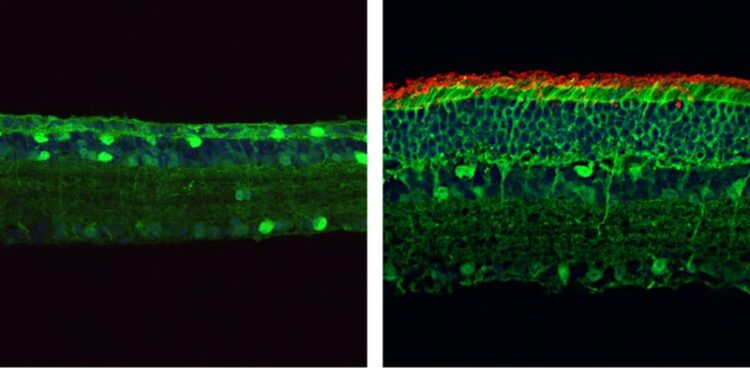New gene-editing technique reverses vision loss in mice

By the age of four months, the retinas of mice carrying a mutation in the gene encoding PDE6β (left) are thin and lack rod photoreceptors (red). But mice who have had this mutation corrected through the PESpRY system (right) have much thicker retinas containing numerous rod cells.
Credit: © 2023 Qin et al. Originally published in Journal of Experimental Medicine. https://doi.org/10.1084/jem.20220776
Researchers in China have successfully restored the vision of mice with retinitis pigmentosa, one of the major causes of blindness in humans. The study, to be published March 17 in the Journal of Experimental Medicine, uses a new, highly versatile form of CRISPR-based genome editing with the potential to correct a wide variety of disease-causing genetic mutations.
Researchers have previously used genome editing to restore the vision of mice with genetic diseases, such as Leber congenital amaurosis, that affect the retinal pigment epithelium, a layer of non-neuronal cells in the eye that supports the light-sensing rod and cone photoreceptor cells. However, most inherited forms of blindness, including retinitis pigmentosa, are caused by genetic defects in the neural photoreceptors themselves.
“The ability to edit the genome of neural retinal cells, particularly unhealthy or dying photoreceptors, would provide much more convincing evidence for the potential applications of these genome-editing tools in treating diseases such as retinitis pigmentosa,” says Kai Yao, a professor at the Wuhan University of Science and Technology.
Retinitis pigmentosa can be caused by mutations in over 100 different genes and is estimated to impair the vision of 1 in 4,000 people. It begins with the dysfunction and death of dim light-sensing rod cells, before spreading to the cone cells required for color vision, eventually leading to severe, irreversible vision loss.
Yao and colleagues attempted to rescue the vision of mice with retinitis pigmentosa caused by a mutation in the gene encoding a critical enzyme called PDE6β. To do this, Yao’s team developed a new, more versatile CRISPR system called PESpRY, which can be programmed to correct many different types of genetic mutation, regardless of where they occur within the genome.
When programmed to target the mutant PDE6β gene, the PESpRY system was able to efficiently correct the mutation and restore the enzyme’s activity in the retinas of mice. This prevented the death of rod and cone photoreceptors and restored their normal electrical responses to light.
Yao and colleagues performed a variety of behavioral tests to confirm that the gene-edited mice retained their vision even into old age. For example, the animals were able to find their way out of a visually guided water maze almost as well as normal, healthy mice and showed typical head movements in response to visual stimuli.
Yao cautions that much work still needs to be done to establish both the safety and efficacy of the PESpRY system in humans. “However, our study provides substantial evidence for the in vivo applicability of this new genome-editing strategy and its potential in diverse research and therapeutic contexts, in particular for inherited retinal diseases such as retinitis pigmentosa,” Yao says.
Qin et al. 2023. J. Exp. Med. https://rupress.org/jem/article-lookup/doi/10.1084/jem.20220776?PR
About Journal of Experimental Medicine
Journal of Experimental Medicine (JEM) publishes peer-reviewed research on immunology, cancer biology, stem cell biology, microbial pathogenesis, vascular biology, and neurobiology. All editorial decisions on research manuscripts are made through collaborative consultation between professional scientific editors and the academic editorial board. Established in 1896, JEM is published by Rockefeller University Press, a department of The Rockefeller University in New York. For more information, visit jem.org.
Visit our Newsroom, and sign up for a weekly preview of articles to be published. Embargoed media alerts are for journalists only.
Follow JEM on Twitter at @JExpMed and @RockUPress.
Journal: Journal of Experimental Medicine
DOI: 10.1084/jem.20220776
Method of Research: Experimental study
Subject of Research: Animals
Article Title: Vision rescue via unconstrained in vivo prime editing in degenerating neural retinas
Article Publication Date: 17-Mar-2023
Media Contact
Ben Short
Rockefeller University Press
bshort@rockefeller.edu
Office: 212-327-7053
All latest news from the category: Life Sciences and Chemistry
Articles and reports from the Life Sciences and chemistry area deal with applied and basic research into modern biology, chemistry and human medicine.
Valuable information can be found on a range of life sciences fields including bacteriology, biochemistry, bionics, bioinformatics, biophysics, biotechnology, genetics, geobotany, human biology, marine biology, microbiology, molecular biology, cellular biology, zoology, bioinorganic chemistry, microchemistry and environmental chemistry.
Newest articles

First-of-its-kind study uses remote sensing to monitor plastic debris in rivers and lakes
Remote sensing creates a cost-effective solution to monitoring plastic pollution. A first-of-its-kind study from researchers at the University of Minnesota Twin Cities shows how remote sensing can help monitor and…

Laser-based artificial neuron mimics nerve cell functions at lightning speed
With a processing speed a billion times faster than nature, chip-based laser neuron could help advance AI tasks such as pattern recognition and sequence prediction. Researchers have developed a laser-based…

Optimising the processing of plastic waste
Just one look in the yellow bin reveals a colourful jumble of different types of plastic. However, the purer and more uniform plastic waste is, the easier it is to…



